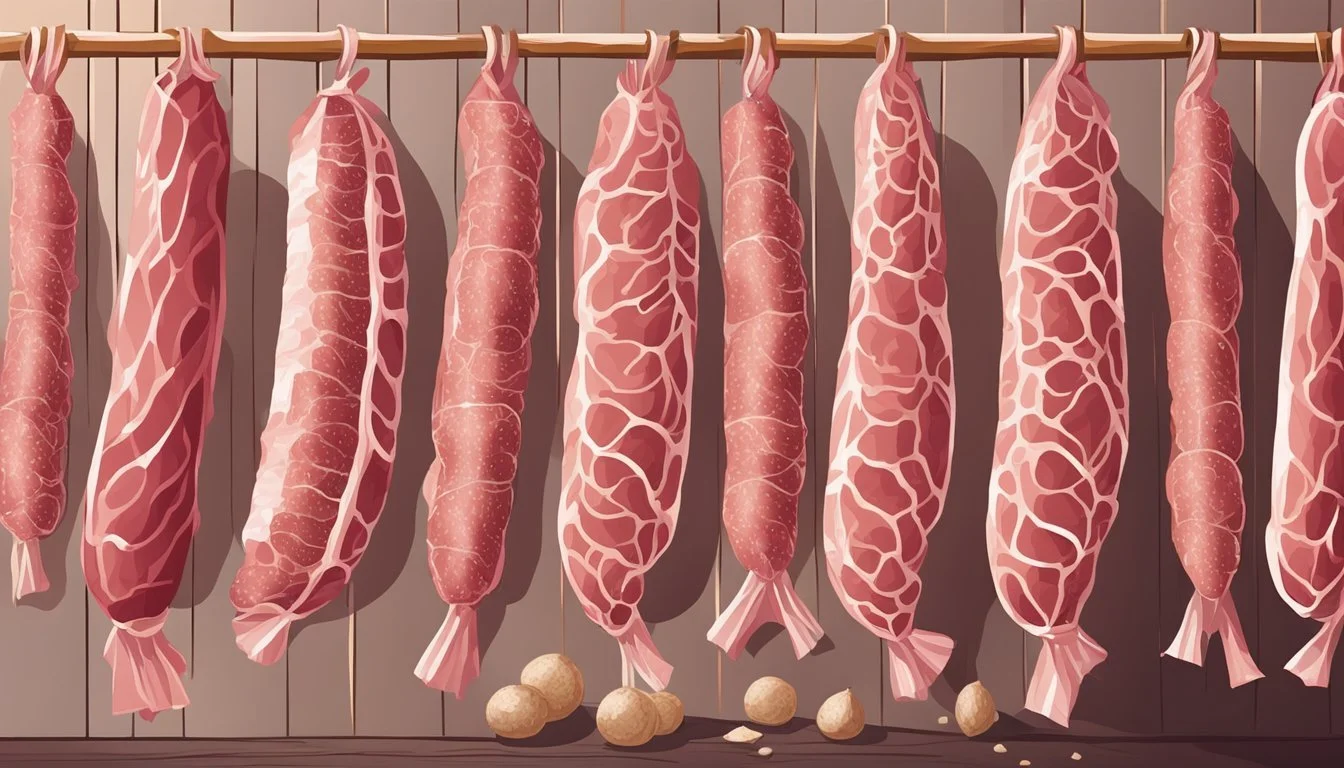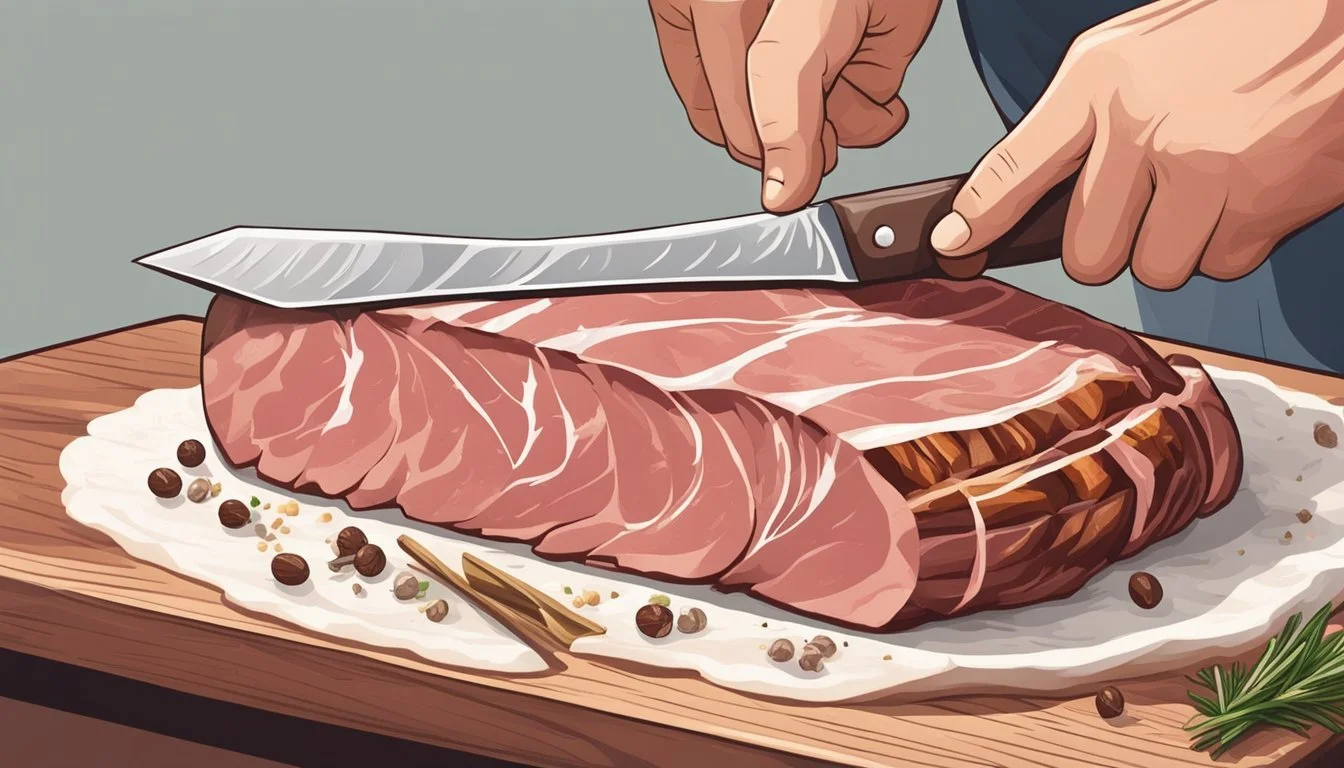Crafting Homemade Genoa Salami
A Step-by-Step Guide for Novices
Crafting homemade Genoa salami is both an art and a science, an endeavor that allows culinary enthusiasts to explore the rich traditions of Italian charcuterie (What wine goes well with charcuterie?). This variety of salami, originating from the Genoa region in Italy, is renowned for its delicate balance of savory flavors and a hint of smokiness, achieved through a meticulous process of fermentation and drying. The process begins with choosing the right cuts of meat—typically pork— which are then ground, seasoned with a carefully selected blend of spices, and inoculated with beneficial starter cultures to ensure proper fermentation.
The spice blend is integral to Genoa salami's distinct taste, often including coriander, mace, allspice, and fennel, with herbs such as marjoram, thyme, and basil adding aromatic depth. The meat mixture must be kept chilled to prevent undesirable bacteria from proliferating, ensuring a safe and successful fermentation process. Once the ground meat is mixed with its seasonings and cultures, it is stuffed into casings and left to ferment to achieve the desired acidity level before entering the drying phase, which concentrates the salami's flavor and achieves its characteristically firm texture.
Understanding Salami Fundamentals
Salami is a type of cured meat predominantly made from pork. It's essential to appreciate the basic components that contribute to its unique characteristics.
Flavor: The flavor profile of salami is a delicate balance of meatiness augmented with salt and a variety of spices and herbs. Traditionally, coriander, mace, allspice, fennel, marjoram, thyme, and basil are used to create a robust and distinctive taste.
Meat Preparation: Careful preparation of the meat is critical. The pork, and sometimes beef, must be cleaned of any connective tissue and ground to the correct coarseness. Pork is often ground coarser than beef.
Temperature and pH: Throughout the process, maintaining a low temperature is essential to prevent spoilage. The mixture should be kept below 34°F. Additionally, the pH level is a marker of successful fermentation; it affects flavor development and safety.
Key Factor Purpose Salt Preserves meat and aids in flavor development and texture. Ground Meat Provides foundation for salami’s structure and flavor. Temperature Ensures safe fermentation and curing process. pH Level Indicates fermentation success and safety.
Varieties: Salami comes in numerous varieties, with Genoa salami being one of the most well-known. It's characterized by a specific mix of spices and a tender, yet firm texture.
Cured Meat: Salami is a form of preserved meat, with the curing process allowing it to be stored for extended periods if kept in optimal conditions between 40-50°F.
By understanding these fundamentals, one can appreciate salami's complexity and the craft involved in producing this protein-rich delicacy.
Essential Ingredients
The success of homemade Genoa salami hinges on the quality and blend of its essential ingredients. From selecting premium cuts of meat to the precise balance of spices, each component plays a critical role.
Selecting Quality Meat
For Genoa salami, one should opt for pork back fat and a mix of pork and beef. The pork back fat contributes to the classic texture and flavor, while the leaner meats provide structure. The meat must be fresh, properly cleaned of silver skin and arteries, and kept chilled during preparation.
Choosing Flavoring Spices
A well-crafted blend of spices is vital to achieve authentic Genoa salami's aroma and taste. Typical spice combinations include:
Garlic: a staple for its robust flavor
Fennel Seed: adds a sweet, anise-like taste
Paprika: imparts a warm, slightly sweet note
Coriander: for a citrusy hint
Peppercorns: whole or crushed for a spicy kick
For a balanced spice mix, adhere to a precise ratio, often a closely guarded secret in traditional recipes.
Salt and Curing Agents
Salt is not just a flavor enhancer but also a preservative for Genoa salami. Alongside salt, curing agents like nitrate or nitrite salts are used to inhibit bacterial growth. It’s crucial to use them in exact amounts to ensure safety and taste:
Salt: approximately 2.5-3% of the meat weight
Curing salts: follow the product guidelines for the correct quantity
Equipment and Preparation
Crafting Genoa Salami at home requires meticulous preparation and specific equipment to ensure successful results. The novice charcutier needs to understand the importance of proper casings for stuffing and the correct setup of a curing chamber to manage temperature and humidity.
Casing and Stuffing
For Genoa Salami, natural casings are typically used because they allow the salami to breathe and dry out evenly. It is advisable to opt for hog casings, which should be soaked in lukewarm water for 5–10 minutes to improve their elasticity. When stuffing, ensure no air pockets form as this can spoil the salami. A sausage stuffer is essential for this process, and one should fill the casings firmly, but with care to avoid rupture.
The Curing Chamber Setup
The optimal curing chamber is critical for the drying phase of the salami. This environment should maintain a steady temperature of around 55°F (13°C) and a humidity level between 70-80%. A modified refrigerator with a temperature and humidity controller can serve as a DIY curing chamber. Reliable thermometers and hygrometers are vital, ensuring the chamber's conditions stay consistent. Regular monitoring is key to success in the curing process.
The Curing Process
The key to crafting exquisite Genoa salami lies in the precise control of environmental conditions during the curing process. This complex stage leverages natural bacteria for fermentation and pH reduction, which contributes to the salami's flavor, safety, and longevity.
Controlling Humidity and Temperature
For optimal curing conditions, one must maintain a careful balance between humidity and temperature. These variables work in tandem to create an environment conducive to beneficial bacterial growth while preventing undesirable organisms from spoiling the meat.
Ideal Temperature Range: 55-60°F (13-15°C)
Ideal Humidity Range: 75-85%
The curing chamber should be equipped with a reliable humidistat and thermometer to monitor and adjust these conditions. Consistent temperatures and humidity levels ensure uniform drying, which is crucial for preventing case hardening, where the outside of the salami dries too fast, making it difficult for moisture to escape from the center.
Monitoring Fermentation and PH Levels
Fermentation is the metabolic process where bacteria convert sugars in the meat to lactic acid, resulting in a drop in pH. This acidification is essential for the development of the salami's characteristic tangy flavor and acts as a natural preservative. Salami makers must meticulously monitor these changes to ensure safety and quality.
Key Metrics:
Target pH: Around 5.3
Aging Time: Varies, but typically several weeks to months depending on size
By tracking pH levels through the use of pH meters or test strips, they can confirm that fermentation is progressing correctly. A steady and controlled drop in pH indicates a successful fermentation process, important for both flavor development and inhibiting the growth of harmful bacteria. After reaching the target pH, the salami continues to age, allowing flavors to mature and the texture to become firm before it is ready to be enjoyed.
Safety and Sanitation
When embarking on making homemade Genoa salami, food safety is of paramount importance. Sanitation begins with the proper handling of ingredients and maintains strict cleanliness throughout the process.
Preparation: Start by thoroughly cleaning and disinfecting all work surfaces and utensils. They should keep their hands washed regularly and consider wearing disposable gloves during meat handling.
Temperature Control: Meats should be kept chilled below 35°F to inhibit bacterial growth. When grinding meat, equipment and meat must remain cold, making partial freezing of the meat beneficial.
Stage Temperature Recommendation Grinding Below 35°F Mixing Below 35°F Fermenting Controlled according to recipe Drying As directed by recipe
During fermentation, they should monitor the temperature and humidity carefully to ensure it encourages beneficial bacteria while discouraging harmful ones. An accurate digital thermometer should be used to check internal temperatures.
Starter Cultures: It is essential to use the right amount of starter culture and prepare it as per the manufacturer’s instructions. This promotes good bacteria and lowers the pH safely and effectively.
Curing Salts: They should carefully measure curing salts and mix evenly with the meat to prevent bacterial growth, especially botulism.
Personal Hygiene: As with any food preparation, the individual should maintain excellent personal hygiene, removing any risks of contaminating the meat with pathogens.
One must always follow recipes and instructions accurately, without shortcuts, especially when it concerns safety guidelines. Properly aging and curing the salami is not only crucial for flavor but also for safety.
Aging and Flavor Development
The aging process is crucial in the creation of Genoa salami, directly influencing its flavor profile and texture. Once the salami is stuffed into its casing, the aging begins. This period can vary from a few weeks to several months, depending on the desired outcome.
During aging, complex biochemical reactions occur, including the breakdown of proteins and fats, which develop the salami's distinctive flavors and aromas. A well-aged salami often exhibits a taste that is richly savory with hints of sharpness, and with a complexity that can include subtle notes of garlic, pepper, and wine.
The texture also alters as the salami matures. Initially, the meat mixture is somewhat soft. As moisture is lost—typically targeting a 40% reduction—the salami becomes firmer. This reduction in moisture must occur in a controlled environment, ideally with specific humidity and temperature settings, to ensure a uniformly dried product.
Aging Factor Effect on Salami Time Develops depth in flavor Moisture Loss Results in firmer texture Controlled Temp Ensures even drying and safety Controlled Humidity Prevents spoilage and overly dry edges
As the proteins break down into peptides and amino acids, they impart the Genoa salami with an appealing and nuanced flavor profile. The balanced distribution of fat within the meat also enhances the mouthfeel, making for a product that is both pleasing to the palate and versatile in its culinary uses.
It's pivotal that the maker regularly checks the salami throughout the aging process. These checks ensure that the product is maturing correctly and helps to prevent any spoilage or undesirable changes in flavor or texture.
Creative Variations and Ingredients
Creating homemade Genoa salami offers an exciting opportunity to experiment with flavors and cater to different dietary needs. This section will explore how different ingredients can diversify your salami, from traditional to contemporary twists.
Experimenting with Spices and Herbs
The delicate balance of spices and herbs is crucial in defining Genoa salami's flavor. A typical spice blend may include:
4 parts coriander
3 parts mace
2 parts allspice
1 part fennel
To complement the spices, herbs like marjoram, thyme, and basil can be proportioned accordingly. For every kilogram of salami, approximately 1.5 grams of this spice blend and 1 gram of herbs can be added for an authentic taste.
Incorporating Nuts and Fruits
Adding nuts and fruits to Genoa salami isn't traditional, but they can introduce an interesting texture and flavor. One can consider chopping pistachios or walnuts for a crunchy contrast, or adding dried fruits such as apricots or figs for a subtle sweetness. These additions should be used sparingly to maintain the integrity of the meat's flavor profile.
Suggested Ratios for Nuts and Fruits:
Nuts: 1/4 cup per 2 pounds of meat mixture
Fruits: 1/3 cup per 2 pounds of meat mixture (finely chopped)
Alternatives for Dietary Restrictions
For those with dietary restrictions, variations in the ingredients are possible. Instead of traditional pork, turkey or chicken can be used as a leaner alternative. Incorporating gluten-free and low-sodium alternatives for spice blends is also an option. This includes substituting regular salt with its lower sodium counterpart or using tamari instead of traditional soy sauce if gluten is a concern. Additionally, while wine is often used for its acidic properties and flavor, one might use a splash of apple cider vinegar for a similar effect without the alcohol content.
Serving and Presentation
Proper serving and presentation profoundly enhance the experience of enjoying Genoa salami. From the ideal slicing technique to pairings that complement the salami’s flavors, each detail contributes to a memorable tasting.
Slicing and Storage Tips
To ensure the best flavor and texture, Genoa salami should be sliced thinly and served at room temperature. Storage is crucial; it should be kept in a cool, dry place between 40-50°F (4-10°C) and can last for several months if preserved properly.
Pairings and Accompaniments
Choosing the right pairings can elevate the salami's flavor. To complement its richness, consider serving it with a variety of cheeses such as bold Gorgonzola, sharp Provolone, nutty Manchego, or creamy Goat Cheese. For beverages, a robust red wine or a crisp apple cider can make for an excellent pairing.
Building an Appealing Charcuterie Board
When constructing a charcuterie board, variety and balance are key. Include different textures and flavors:
Cheeses: A selection like earthy Parmesan, smoky Gouda, and tangy Feta offers diversity.
Fruits and Vegetables: Sweet slices of apple or tangy pickles add a refreshing counterpoint to the meats.
Breads and Crackers: Offer a mix of crunchy options, such as artisanal crackers or crusty bread.
Condiments: Small bowls of olive oil, honey, or mustard can be used for dipping or drizzling.
Olives and Nuts: Varieties like Kalamata olives or almonds give a briny or earthy touch to the board. The salami's presentation should be both visually appealing and practical, enhancing the overall tasting experience.
Incorporating Genoa Salami into Recipes
Genoa salami enhances a variety of dishes with its robust flavor. It can be incorporated skillfully into both classic and modern recipes, lending a touch of traditional Italian taste or creating a delightful fusion of flavors.
Classic Italian Dishes
One can create authentic Italian experiences by including Genoa salami in traditional recipes. A step-by-step guide to crafting a Classic Genoa Salami Pasta might begin with selecting a simple yet flavorful base, such as a garlic and olive oil sauce. Here is a brief instruction for two classic dishes:
Pasta with Genoa Salami:
Cook pasta of choice until al dente.
In a pan, sauté chopped Genoa salami in olive oil until slightly crisp.
Add garlic and a dash of vinegar, cooking for another minute.
Toss the salami and sauce through the pasta, finishing with grated cheese.
Salami and Spinach Pizza:
Roll out pizza dough and brush with olive oil.
Spread a thin layer of pizza sauce over the base.
Top with slices of Genoa salami, spinach, and mozzarella cheese.
Bake until the crust is golden and cheese is bubbly.
Modern Cuisine Fusion
Genoa salami's adaptability shines in modern dishes that feature a blend of different culinary traditions. Creative chefs might experiment with ingredients like pesto or vegetables to bring a fresh twist. For instance:
Pesto Salami Fusion Pasta:
Prepare a pesto using fresh basil, pine nuts, parmesan, olive oil, and garlic.
Toss cooked pasta with the pesto and add thinly sliced Genoa salami.
Garnish with diced sun-dried tomatoes for a contemporary twist.
Salami Vegetable Mélange:
Thinly slice Genoa salami and a selection of vegetables such as zucchini and bell peppers.
Sauté the vegetables in olive oil until tender-crisp.
Add the salami at the end to keep its texture firm, drizzling with balsamic vinegar before serving.
By following these step-by-step instructions, cooks can incorporate Genoa salami into various culinary creations, enhancing flavors and textures, whether abiding by Italian traditions or venturing into the territory of modern fusion cuisines.
Conclusion
Crafting Genoa salami at home can be an intricate and rewarding endeavor. The success lies in careful attention to the chilling and grinding of the meat, and the precision in mixing seasonings and starter cultures. One must ensure the meat is kept below 35°F during initial preparation, and that seasonings are carefully measured—about 1.5g of spices and 1g of herbs for 1kg of salami.
The fermentation process is critical, requiring one to monitor until the pH reaches the target point. Drying must then be conducted in a controlled environment, aspiring to a 40% moisture loss to achieve the characteristic firm texture.
When it comes to flavor, Genoa salami shines with a harmonious blend of spices and herbs, which may include coriander, mace, allspice, fennel for spices, and marjoram, thyme, and basil for herbs. The inclusion of red wine in some recipes can enhance the depth of flavor.
Storage is also key—Genoa salami thrives in a cool, dry place, ideally between 40-50°F (4-10°C), extending its shelf life for several months when cured and preserved correctly.
The craft of making Genoa salami at home allows for a touch of artisanal charm and a connection to the Italian culinary tradition. With dedication to the process and an eye for detail, the maker can take pleasure in creating a product that not only resonates with authentic taste but also stands as a testament to their skill and passion for charcuterie.








